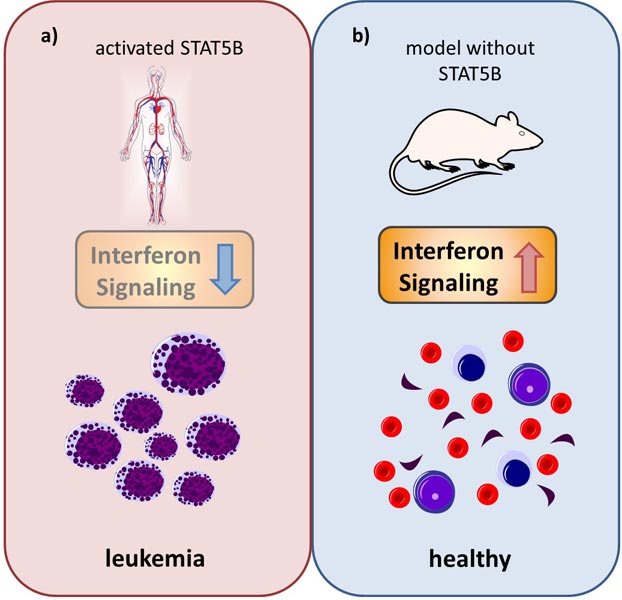

a) Patients with an activating STAT5B mutation display a suppressed interferon response, which promotes the development and growth of leukemia cells.
b) In the STAT5B-deficient leukemia mouse model, the increased interferon response led to a suppression of malignant leukemia cells. This reveals STAT5B as a potential target for anti-cancer medication.
©Institute of Pharmacology and Toxicology/Vetmeduni Vienna
STAT5B as a potential target for anti-cancer medication
STAT5 important for cancer-causing BCR/ABL gene
The BCR/ABL gene, which does not occur among healthy people, has been shown to be a causative agent in the pathogenesis of B-cell acute lymphocytic leukemia. The gene causes white blood cells to become leukemia cells that reproduce out of control.
Earlier studies by the research group of Veronika Sexl at Vetmeduni Vienna had already shown that the STAT5 transcription factor was essential for the development of BCR/ABL-induced leukemia. The solution seemed simple: remove STAT5 and the tumor cell dies.
STAT5A and STAT5B: Not everything that looks the same is the same
But STAT5 actually consists of two genes: STAT5A and STAT5B. The two are very similar and, being more than 90 % identical, had been considered to be functionally equal. Research had therefore focused primarily on the function of STAT5A, as it had appeared to be of greater importance.
In their recently published study in the journal Leukemia, the researchers from Vetmeduni Vienna wanted to know for sure. Veronika Sexl from the Institute of Pharmacology and Toxicology at Vetmeduni Vienna was the director of the study:
“In our previous studies, we always turned off both genes, as they are situated next to each other on the chromosome. What is exciting is that in recent years cases have been found of patients with mutations that result in STAT5 activation and are assumed to drive disease. Surprisingly, these mutations were found at a much higher frequency in STAT5B than in STAT5A.”
This finding led the research team to ask: Why are mutations found in STAT5B and not in STAT5A? And why is overactivation of STAT5B “good” for the tumor cell?
STAT5B: Therapeutic approach: new, precision medicine strategies
The Vetmeduni Vienna research team probed these questions by investigating the different function of STAT5A and STAT5B in a mouse model and in human leukemia cells. The absence of STAT5A led to a decrease in cell survival and the formation of colonies of malignant cancer cells.
Even more significant effects were observed in the absence of STAT5B. In the mouse model, loss of STAT5B increased interferon response and suppressed transformation. The opposite scenario was the case in patients with overactive STAT5B: the interferon response against tumor growth was suppressed, and transformation was enhanced.
Andrea Hölbl-Kovacic from Vetmeduni Vienna: “Our data show that STAT5A and STAT5B are twins with different personalities, and that STAT5B facilitates leukemogenesis in BCR/ABL leukemia. Our findings might help explain the high frequency of STAT5B mutations in hematopoietic tumors.”
According to the researchers, this may be of direct clinical relevance for patients, as a better understanding of the complex role of STAT5B could enable the development of precision medicine strategies to treat disease.
About the University of Veterinary Medicine, Vienna
The University of Veterinary Medicine, Vienna in Austria is one of the leading academic and research institutions in the field of Veterinary Sciences in Europe. About 1,300 employees and 2,300 students work on the campus in the north of Vienna which also houses five university clinics and various research sites. Outside of Vienna the university operates Teaching and Research Farms. The Vetmeduni Vienna plays in the global top league: in 2018, it occupies the excellent place 6 in the world-wide Shanghai University veterinary in the subject “Veterinary Science”. http://www.vetmeduni.ac.at
Released by:
Georg Mair
Science Communication / Corporate Communications
University of Veterinary Medicine Vienna (Vetmeduni Vienna)
T +43 1 25077-1165
E georg.mair@vetmeduni.ac.at
Andrea Hölbl-Kovacic
Institute of Pharmacology and Toxicology
University of Veterinary Medicine Vienna (Vetmeduni Vienna)
T +43 1 25077-2900
E Andrea.Hoelbl@vetmeduni.ac.at
The article “Twins with different personalities: STAT5B – but not STAT5A – has a key role in BCR/ABL-induced leukemia” by Sebastian Kollmann, Eva Grundschober, Barbara Maurer, Wolfgang Warsch, Reinhard Grausenburger, Leo Edlinger, Jani Huuhtanen, Sabine Lagger, Lothar Hennighausen, Peter Valente, Thomas Decker, Birgit Strobl, Mathias Müller, Satu Mustjoki, Andrea Hölbl-Kovacic and Veronika Sexl was published in Leukemia. https://www.nature.com/articles/s41375-018-0369-5
Released by
Nina Grötschl
Science Communication / Corporate Communications
University of Veterinary Medicine Vienna (Vetmeduni Vienna)
T +43 1 25077-1187
https://www.vetmeduni.ac.at/en/infoservice/press-releases/press-releases-2019/ne…












